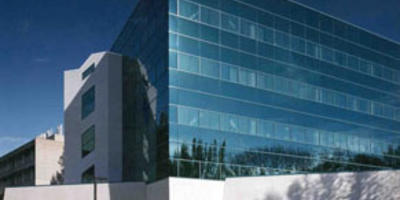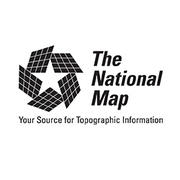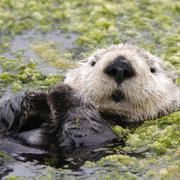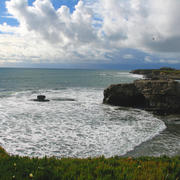Due to a lapse in appropriations, the majority of USGS websites may not be up to date and may not reflect current conditions. Websites displaying real-time data, such as Earthquake and Water and information needed for public health and safety will be updated with limited support. Additionally, USGS will not be able to respond to inquiries until appropriations are enacted. For more information, please see www.doi.gov/shutdown
Regions
Pacific
Regions L2 Landing Page Tabs
The Pacific Region has nine USGS Science Centers in California, Nevada, and Hawaii. The Regional Office, headquartered in Sacramento, provides Center oversight and support, facilitates internal and external collaborations, and works to further USGS strategic science directions. Our scientists do a broad array of research and technical assistance throughout the U.S. and across the globe.
USGS is the nation's premiere earth and natural science research organization. Because our core mission is to provide objective science and technical support to address a wide array of important societal issues, our capabilities and activities are diverse. Our work is conducted by employees at our Science Centers, and in collaboration with our many external partners.
Biology, Impacts and Control of Invasive Reptiles
Invasive species are considered to be second only to habitat degradation in terms of negative impacts on the Earth’s ecosystems, and our scientists make up a significant proportion of the global expertise in the rapidly-growing problem of invasive reptiles.
USGS Brown Treesnake Laboratory and Rapid Response Facility - Guam
USGS scientists and staff associated with the Brown Treesnake Project are co-located at the Guam National Wildlife Refuge at the northern end of Guam in the western Pacific Ocean. Project staff work on developing and testing control tools for invasive brown treesnakes, as well as understanding their impacts on Guam's ecosystems. Project staff also lead the multi-agency Brown Treesnake Rapid...
Survival and Reintroduction of the Laysan Teal
The Challenge: The Laysan Teal is an endangered, endemic, Hawaiian dabbling duck that has been pushed to the brink of extinction numerous times. The previous range includes the Main and Northwestern Hawaiian Islands, and its current range is less than 10 sq. km within the National Wildlife Refuges of Papahānaumokuākea Marine National Monument. This non-migratory waterfowl was eliminated from...
Box Springs Field Station
Deserts in the southwestern United States are experiencing rapid changes due to human activities. The growth of human populations and development of cities and towns affect adjacent rare, threatened, and endangered species and their associated ecosystems in the Mojave and Sonoran deserts of southeastern California, southern Nevada, southwestern Utah, and western Arizona.
Molecular Ecology Lab (MEL)
The Molecular Ecology Laboratory applies genetic and genomic technologies to address a variety of complex questions and conservation issues facing the management of the Nation's fish and wildlife resources. Together with our partners, we design and implement studies to document genetic diversity and the distribution of genetic variation among individuals, populations, and species. Information...
Control and Landscape-Scale Suppression of the Invasive Brown Treesnake
The Brown Treesnake is a highly destructive reptile species that has extirpated many native species of birds, bats, and lizards from the U.S. Territory of Guam. For more than two decades branch scientists with the Invasive Reptile Project have developed, validated, and tested the feasibility of Brown Treesnake control and suppression at various spatial scales.
National Geospatial Program User Engagement Office
Would you like to learn more about USGS National Map products and services? Then welcome to the National Geospatial Program User Engagement office. We can help you leverage NGP products and services through The National Map and other venues. Connect with us through our network of National Map Liaisons. There's a liaison for every state!
Development of an Environmental Assessment and Eradication Plan to Remove Tilapia from Ponds and Wetlands in National Parks on the Island of Hawai’i
Mozambique tilapia, a highly invasive non-native fish of the family Cichlidae, were discovered in a wetland in Kaloko-Honokohau National Historical Park on the Big Island of Hawai'i. As the U.S. National Park Service works to restore the natural communities and functions of wetland ecosystems on the island, the eradication of the tilapia population is considered necessary to fully achieve...
Understanding Coastal Change
Scientists perform a range of studies that document, assess, and model coastal change, risk, and vulnerability. Studies include historical shoreline change, the geologic structure and history of coastal regions, sediment supply and transport, sea-level rise, and how extreme storm events affect rates and impacts of coastal change.
Geologic Hazards and Catastrophic Events
We study the distribution and hazard potential of coastal and submarine events such as earthquakes and submarine landslides and associated tsunami potential, hurricane induced coastal inundation, extreme storms, sea-level rise and oil and gas spills. We also model development to help evaluate and forecast coastal hazard probability and occurrence.
Ocean Resources for America's Needs
Our scientists conduct research studies focused on geologic mapping, sampling and understanding of mineral and energy resources and studies of the geologic setting and processes to inform renewable energy development offshore.
Coastal and Marine Ecosystem Science
We bring together multidisciplinary expertise focused on developing tools and models to improve understanding of how healthy ecosystems function as well as how they respond to environmental changes and human impacts including ecosystem restoration. Research studies address coral reef, coastal wetland, benthic habitat and groundwater resources.
USGS is known for the producing objective, high-quality data that is relevant to decision-makers, resource managers, the scientific community, and the public. We are recognized as the world leader in making data and tools readily available; as a result, our tools and data are widely used to better understand our world and protect human life and property.
Elevation Data

The 3DEP products and services available through The National Map consist of lidar point clouds (LPC), standard digital elevation models (DEMs) at various horizontal resolutions, elevation source and associated datasets, an elevation point query service and bulk point query service. All 3DEP products are available, free of charge and without use restrictions.
Coastal and Marine Geology Video and Photography Portal

This portal contains U.S. Geological Survey (USGS) video and photography of the seafloor off of coastal California and Massachusetts, and aerial imagery of the coastline along segments of the Gulf of Mexico and mid-Atlantic coasts. These data were collected as part of several USGS Coastal and Marine Geology Program Seafloor Mapping projects and Hurricane and Extreme Storm research.
Coastal and Marine Geoscience Data System

Site provides access to Coastal and Marine Geology Program (CMGP) data via Open Geospatial Consortium (OGC) standards services; serving data to GeoMapApp and Virtual Ocean 2-D and 3-D earth browsing tools, for data integration, visualization and analysis; and metadata catalogs for data discovery.
California State Waters Map Series Data Catalog

GIS data files for map areas offshore of California are listed with a brief description, a small image, and links to the metadata files and the downloadable data files.
USGS is a world leader in producing and distributing maps and geospatial data, ranging from local to national scales.
Links to publications that contain maps of the sea floor or lake beds and the digital data used to create them.
This portal is a “go to” source for maps related to ocean and coastal mapping. Information is organized by geography or region, by theme, and by the year data was published.
Kelp, cobbles, and currents: Biologic reduction of coarse grain entrainment stress
Models quantifying the onset of sediment motion do not typically account for the effect of biotic processes because they are difficult to isolate and quantify in relation to physical processes. Here we investigate an example of the interaction of kelp (Order Laminariales) and coarse sediment transport in the coastal zone, where it is possible to...
Masteller, Claire C; Finnegan, Noah J; Warrick, Jonathan; Miller, Ian M.USGS science at work in the San Francisco Bay and Sacramento-San Joaquin Delta estuary
The San Francisco Bay and Sacramento-San Joaquin Delta form one of the largest estuaries in the United States. The “Bay-Delta” system provides water to more than 25 million California residents and vast farmlands, as well as key habitat for birds, fish, and other wildlife. To help ensure the health of this crucial estuary, the U.S. Geological...
Shouse, Michelle K.; Cox, Dale A.Calculation of hydrocarbon-in-place in gas and gas-condensate reservoirs - Carbon dioxide sequestration
The Energy Independence and Security Act of 2007 (Public Law 110-140) authorized the U.S. Geological Survey (USGS) to conduct a national assessment of geologic storage resources for carbon dioxide (CO2), requiring estimation of hydrocarbon-in-place volumes and formation volume factors for all the oil, gas, and gas-condensate reservoirs within the...
Verma, Mahendra K.Mercury-contaminated hydraulic mining debris in San Francisco Bay
The hydraulic gold-mining process used during the California Gold Rush and in many developing countries today contributes enormous amounts of sediment to rivers and streams. Commonly, accompanying this sediment are contaminants such as elemental mercury and cyanide used in the gold extraction process. We show that some of the mercurycontaminated...
Bouse, Robin M.; Fuller, Christopher C.; Luoma, Samuel N.; Hornberger, Michelle I.; Jaffe, Bruce E.; Smith, Richard E.Estuarine sedimentation, sediment character, and foraminiferal distribution in central San Francisco Bay, California
Central San Francisco Bay is the deepest subembayment in the San Francisco Bay estuary and hence has the largest water volume of any of the subembayments. It also has the strongest tidal currents and the coarsest sediment within the estuary. Tidal currents are strongest over the west-central part of central bay and, correspondingly, this area is...
Chin, John L.; Woodrow, Donald L.; McGann, Mary; Wong, Florence L.; Fregoso, Theresa A.; Jaffe, Bruce E.Spatial trends in tidal flat shape and associated environmental parameters in South San Francisco Bay
Spatial trends in the shape of profiles of South San Francisco Bay (SSFB) tidal flats are examined using bathymetric and lidar data collected in 2004 and 2005. Eigenfunction analysis reveals a dominant mode of morphologic variability related to the degree of convexity or concavity in the cross-shore profileindicative of (i) depositional, tidally...
Bearman, J.A.; Friedrichs, Carl T.; Jaffe, B.E.; Foxgrover, A.C.The annual cycles of phytoplankton biomass
Terrestrial plants are powerful climate sentinels because their annual cycles of growth, reproduction and senescence are finely tuned to the annual climate cycle having a period of one year. Consistency in the seasonal phasing of terrestrial plant activity provides a relatively low-noise background from which phenological shifts can be detected...
Winder, Monika; Cloern, James E.How humans and nature have shaped the San Francisco Estuary since the Gold Rush
The San Francisco Estuary has undergone dramatic changes since the Gold Rush, as both natural forces and human activities have added and removed massive quantities of sediment, primarily sand and mud. A long-term perspective of sediment movement and patterns of sediment deposition and erosion is vital for effective management of wetlands, sediment...
Jaffe, B.E.A Tidally Averaged Sediment-Transport Model for San Francisco Bay, California
A tidally averaged sediment-transport model of San Francisco Bay was incorporated into a tidally averaged salinity box model previously developed and calibrated using salinity, a conservative tracer (Uncles and Peterson, 1995; Knowles, 1996). The Bay is represented in the model by 50 segments composed of two layers: one representing the channel (...
Lionberger, Megan A.; Schoellhamer, David H.Complex seasonal patterns of primary producers at the land-sea interface
Seasonal fluctuations of plant biomass and photosynthesis are key features of the Earth system because they drive variability of atmospheric CO2, water and nutrient cycling, and food supply to consumers. There is no inventory of phytoplankton seasonal cycles in nearshore coastal ecosystems where forcings from ocean, land and atmosphere intersect....
Cloern, J.E.; Jassby, A.D.Box Model of a Series of Salt Ponds, as Applied to the Alviso Salt Pond Complex, South San Francisco Bay, California
This report documents the development and application of a box model to simulate water level, salinity, and temperature of the Alviso Salt Pond Complex in South San Francisco Bay. These ponds were purchased for restoration in 2003 and currently are managed by the U.S. Fish and Wildlife Service to maintain existing wildlife habitat and prevent a...
Lionberger, Megan A.; Schoellhamer, David H.; Shellenbarger, Gregory; Orlando, James L.; Ganju, Neil K.Western ground water and climate change—pivotal to supply sustainability or vulnerable in its own right?
Dettinger, M.D.; Earman, S.Measuring streamflow in northern Nevada.
USGS technician measuring streamflow in northern Nevada.
Measuring streamflow in the Sisquoc River near Garey, California.
USGS technician measuring streamflow in the Sisquoc River near Garey, California, upstream of the Santa Maria Mesa Road Bridge.
USGS Streamgaging on the Pit River operates year round.
USGS Streamgaging equipment and cableway on the Pit River near Canby, California operates year round.
Lowering an acoustic Doppler current profiler from a cable way.
USGS technicians preparing for a streamflow measurement by lowering an acoustic Doppler current profiler from a cable way on the American River near Fair Oaks, California.
Technicians prepare to board a boat to measure water flow.
USGS technicians prepare to board a boat to go out to the center of the channel in the San Joaquin River below Friant Dam to get an accurate measurement of water flow during releases from the Dam for flood control.
Measuring streamflow in fast moving floodwater.
USGS hydrographer measuring streamflow using a handheld Acoustic Doppler Velocimeter in fast moving floodwater Cajon Creek near Keenbrook, California.
USGS Streamgaging Station in northern Nevada.
USGS Streamgaging Station in northern Nevada.
Examining bucket of seafloor sediment collected off southeast Alaska
USGS research geophysicist Danny Brothers (right) and colleagues examine the surface of a sediment grab sample just pulled onto the deck of the Canadian Coast Guard Ship John P. Tully. The sample was collected from the top of a mud volcano north of the border between southeast Alaska and British Columbia. Expedition scientists are investigating the Queen Charlotte
...Collecting a piston core of seafloor sediment off British Columbia
Scientists prepare to lower a piston corer off Haida Gwaii, British Columbia, to sample seafloor sediment near the Queen Charlotte-Fairweather fault. Expedition scientists are studying layers of sediment in the cores they collected to identify and determine ages of past earthquakes along the fault. This information will help them assess future threats to coastal
...Sampling core fluid from sediment cores collected off southeast Alaska
Mary McGann (left, USGS) and Rachel Lauer (University of Calgary) sample pore fluids from sediment cores collected aboard the Canadian Coast Guard Ship John P. Tully along the Queen Charlotte-Fairweather fault offshore of southeast Alaska. Expedition scientists will use their findings to better understand the history of the fault and the hazards it poses to
...USGS scientist Carol Reiss holding a hydrothermal vent sample
USGS scientist Carol Reiss holding a hydrothermal vent sample. The poster in the background is a scientific rendering by Véronique Robigou (then at University of Washington) of a hydrothermal vent deposit with the submersible Alvin drawn to scale. This structure stood 45 meters above the seafloor when it was discovered by University of Washington researchers using Alvin
...USGS geologist Carol Reiss examining hydrothermal vent sample
USGS geologist Carol Reiss examining hydrothermal vent sample using hand lens. Sulfide-silicate minerals precipitate from 330°C mineral laden water venting along volcanically active spreading ridges.
Research and technical support provided by USGS makes a difference Some recent press releases and media advisories from the Pacific Region are highlighted below.
An international team of scientists just finished probing the depths of the Pacific Ocean offshore of Alaska and British Columbia, to better understand the Queen Charlotte-Fairweather Fault. During the past century, the 700-mile-long fault has generated at least half a dozen major earthquakes, and future shocks threaten coastal communities in both the United States and Canada.
Editor: In the public interest and in accordance with FAA regulations, the USGS is announcing this low-level airborne project. Your assistance in informing the local communities is appreciated.
The U.S. Geological Survey awarded approximately $4.9 million this week to six universities and a university-governed non-profit, to support transitioning the west coast “ShakeAlert” earthquake early warning system into a production system.
A new U.S. Geological Survey-led study suggests that earthquake-related deformation just below the Earth's surface can be quite different from how it is expressed at the surface.
Direct encounters with humans can increase the likelihood that nesting geese will lose their eggs to predators, according to a recent study released Monday, July 17.

Scientists from the USGS Pacific Coastal and Marine Science Center mapped the offshore extent of the Mud Creek landslide on California’s Big Sur coast on July 11, 2017.
Forest birds on the island of Hawaii are responding positively to being restored in one of the largest, ongoing reforestation projects at Hakalau Forest National Wildlife Refuge, according to a new study released July 10 in the journal Restoration Ecology.
Sudden flooding hit islands of global importance for Pacific birds highlighting threats and opportunities for conservation planning
Just like smog and fog, this EarthWord is not what you want to see while driving...
Early on the morning of August 24, 2014, Loren Turner was awoken by clattering window blinds, a moving bed, and the sound of water splashing out of his backyard pool. He experienced what is now named the “South Napa Earthquake.”
Vast mineral wealth has been discovered in the Great Basin since the 1800s. As each new generation of prospectors and geologists brings their cutting-edge tools with them, the arid ridgelines of the desert Southwest have shown more and more potential.
Although no one can reliably predict earthquakes, today’s technology is advanced enough to rapidly detect seismic waves as an earthquake begins, calculate the maximum expected shaking, and send alerts to surrounding areas before damage can occur. This technology is known as “earthquake early warning” (EEW).
Nine USGS Science Centers are administered by the Pacific Regional office, which is headquartered in Sacramento, California.
The Pacific Region works with a wide array of partners across the country, including other Federal and state agencies, regional and local governments, academic institutions, research organizations, non-governmental organizations, and more.



































































